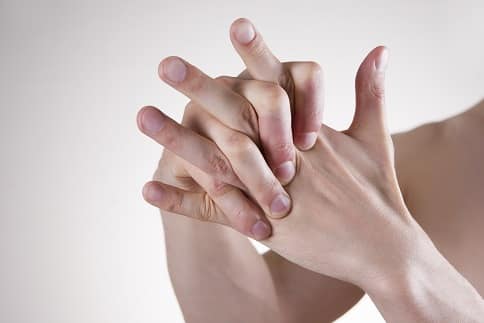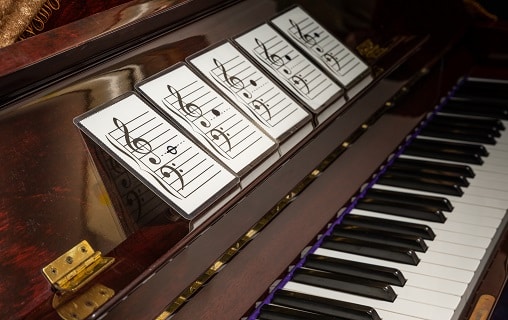As an Amazon Associate I earn from qualifying purchases.
Playing the piano takes a lot of time, effort, and physical ability. For beginner pianists, it’s important to have a set of exercises to help with their musical and technical development.
Below is a list of 17 piano exercises for beginners:
- Five Finger Patterns
- Major and Minor Scales
- Triads
- Repetition Exercises
- Playing Partial Chords
- Shadow Playing
- Sight Reading
- Clapping and Tapping Rhythms
- Focusing On Articulations
- Playing Music Backwards
- Playing Scales In Contrary Motion
- Finger Pedaling
- Finger and Arm Stretches
- Steps and Skips
- Playing Pieces In Different Keys
- Playing Scales In Octaves
- Using Music Flashcards
You might notice that all of these exercises don’t actually involve any playing at all. That’s because beginning pianists should always be working on their musicianship, reading skills, rhythm and more in addition to pressing the keys. Let’s dive into each of these exercises and how they help new pianists develop the right way!
Want to Learn Piano?Click Here

1. Five Finger Patterns
One of the easiest exercises to jump into involves using all five fingers of each hand. This is often called the five finger pattern, which is essentially the first five notes of a scale pattern. Pianists can find a starting position on any of the white keys.
I usually have my students start on C, and play each of the notes going up slowly and then downward slowly. Because of the simplicity of the exercise, it’s a good idea to encourage hands together from the start.
This exercise is helpful for students just learning how to coordinate their hands when playing. It’s also a great opportunity for teachers and students to observe their hand positioning, firmness of the fingers, and work on producing a solid tone. This is also a great exercise for teaching major and minor positions in preparation for scales.
Once the pianist is comfortable playing these at a moderate tempo, they should gradually increase the speed using a metronome. You can start a beginner pianist on C and work all the way up to the next octave C. This allows for playing the same pattern in multiple positions while experiencing different registers and starting pitches.
2. Major and Minor Scales

Once pianists are comfortable playing five finger positions, it’s probably a good idea to introduce complete scales. The easiest way to introduce scales is by analyzing the half steps and whole steps.
A typical major scale pattern follows the WWHWWWH sequence. This is a visual exercise that beginner pianists can do. I ask my students to play the scale first using their index finger only so that they can identify which notes need to be pressed and explore how to measure the distance between the half and whole steps.
The next phase to teach is the fingering itself. Scales follow the same fingering pattern for the most part. The right hand is usually 12312345 while the left hand is the same numbers but in the opposite direction forming 54321321.
Minor scales follow a similar approach with fingering, however, the pattern would now be WHWWHWW instead. While there are many variations of the minor scale, the most a beginner pianist needs to be concerned with is the natural minor.
It’s always a good idea to teach scales hands alone because they move in parallel motion with different fingerings. To help a beginner pianist play scales hands together initially, they should learn how to play these in contrary motion.
3. Triads
A quick 5 – 10-minute warmup for beginner pianists is triads. These are much simpler to understand compared to scales, although some of the same principles apply. To play a triad, the pianist needs to have some knowledge of what skips and steps are.
Triads only involve three pitches. Starting on C, the exercise can start off simple with just one hand playing C, E, and G and then going back down. The next part of the exercise can then be to play the triad in inverted positions.
This would leave you with C, E, G, and followed by E, G, C, and then finally G, C, E and then playing this back on the way down. This lets the pianist play all the notes of the triad from three different positions and covers an entire octave worth of notes.
Like scales, triads can be played in major and minor form. Try to keep things simple and work with the white keys first, playing this in major position only.
4. Repetition Exercises
Speed and agility are important on the piano, and so is repetition. Playing repeated notes with the same finger is never a good idea. For this exercise, I close the fallboard and use the thumb, index, and middle finger. Beginning in one position I’ll repeat the finger pattern of 123, 123, and then move up and do the same thing.
Once I feel comfortable on the fallboard, I open up the piano and try this for real on the keys. Starting with C I play a series of 6 eighth notes and rotate the fingers. The pattern written out would be 123,123. Then I move up to D, and E, and F, and so forth doing the same finger exchanges.
Repetition of notes also becomes difficult when playing partial chords like thirds and fifths, and even octaves. Some of the same logic can be applied here as well. I pretend that I’m actually playing up and down the piano and then open it back up to try it on the keys. The key to good repetition is wise fingering and proper hand positioning.
5. Playing Partial Chords
Most beginner piano music has partial chords instead of full triads or complex harmonies. It’s a good idea to try out some of the Hanon Exercises; they offer a lot of help in this area. Partial chords beginner pianists will deal with the most are clusters of a second, thirds, and open fifths.
One exercise I teach my students is to start off playing a single note, then add in the seconds, thirds, fourths, and fifths. Then I have them play this same exercise backward start with the fifths and ending with the single pitch.
The goal is for them to produce a rich tone, so we try it out with forte and piano dynamics. The more they work on this exercise the more comfortable they become when they see those different partial chords in their repertoire. Especially when it comes to jumping from an open fifth to a more condensed interval of a second, this exercise is really beneficial.
Beginner pianists will have better recognition in their sight reading when those chords occur because these exercises are implemented daily. The hands will also more naturally fall into position as a result through repetition.
6. Shadow Playing
I alluded to shadow playing earlier, but it’s truly an effective technique for new pianists. This involves closing the piano fallboard and playing the notes on the page without the keys in front of you. Shadow playing is a challenge in touch, measuring distance and anticipating fingering.
While pianists can do this on the keys silently, I’ve always found it best to remove the keys completely out of the equation. Because beginner piano music is simple, it’s usually okay to have them shadow play an entire eight measure passage. Once they feel comfortable in their fingering and counting, I open up the keyboard and have them find their hand positions.
After that, they should, for the most part, be able to play the same musical passage they did on the fallboard, with little to no mistakes on the keys themselves.
What shadow playing does most effectively is remove the distraction of tones and staring down piano keys. This allows pianists to really focus on the most important aspects of the music which is the counting, the intervals, and the feel of independent fingers.
7. Sight Reading

There’s perhaps no better development of rhythm and note recognition than sight reading. Too often beginner students get a piece of music, and play it over and over again and never challenge themselves with anything new.
The downside of that is that new music whether that features the same notes and rhythms or something new will almost always appear difficult to them.
Sight reading is an opportunity to keep a beginner pianist engaged. It’s a good idea to start off with 4 – 8 measures of music to read. When sight reading there’s a couple of steps the pianist should follow.
- Look over the key signature
- Analyze any accidentals
- Look for areas that repeat
- Work out the difficult rhythms
- Shadow play the passage slowly
- Play the entire passage at a slow tempo
The first step should be quite easy. Looking over the key signature will help new pianists avoid 90% of the mistakes they might otherwise make for hitting a wrong note that was labeled in the key signature.
After this step, pianists should look for any sharps or flats that are added in. Much of the music pianists play follows some sort of pattern, so it’s important to look for areas where the notes or rhythms are repeated.
If there’s a difficult rhythm that’s tough to count, this area should be worked out before attempting to play anything. I usually have my students tap the rhythm, or shadow play those areas until they feel confident in executing it. The last step is to of course play the passage slowly and try to do it without any mistakes!
Sight reading teaches some really great principles for approaching new music. As a beginner pianist, it’s important to have those concepts down from the start.
8. Clapping and Tapping Rhythms
Rhythm might be just as important as the playing itself. Beginner pianists should be clapping or tapping everything that they plan to perform. It’s a good idea to do this before any shadow playing or touching of the keys.
When clapping or tapping rhythms, the pianist should be counting out loud; not in their head. The more rhythm practice beginner pianists do, the more solid the overall musical foundation will be. I suggest checking out the Piano Jumpstart method book which focuses on rhythm from the very start.
9. Focusing On Articulations
Articulations are really important when it comes to bringing out a certain character in the music. Beginner pianists should have a firm grip on how staccato vs legato should sound. Or if the music has accents, they should be able to properly execute those so that the pulse of the music is there.
A simple articulation exercise is to take a short passage of music and try to play it with all of these different variations. The first run-through might simply be to play as legato as possible. Perhaps the next one will be to play the entire passage with staccato.
To really switch things up the next exercise would be to play some parts legato, and then specific notes staccato. This will help train pianists to be able to make those changes to articulation on the fly. Check out the Czerny Practical Method For Beginners. It has some excellent exercises to help aid with this are of piano playing.
10. Playing Music Backwards
A good exercise to help with building memory is to play music backward. By this, I mean starting from the last measure and then ending with the first. This can be done with a large piece of music, however, it’s best to start this exercise with 4 or 5 measures at a time and then to build on that each week.
Beginner pianists might have some difficulty with this exercise initially, so the exercise should be done with a really simple piece of music that’s short in length. Make sure this is something that can be quickly memorized in a few practice sessions.
Once memorized, it’s a good idea to try to memorize the music from the last measure to the first. The benefit of this exercise is that it helps a new pianist to recognize when certain harmonies occur, no matter which how the music is presented to them. It’s also a great foundation for learning how to memorize piano music faster.
11. Playing Scales In Contrary Motion
Playing scales in parallel motion is not the simplest way to learn them. In my experience, pianists have benefitted more by playing them in contrary motion. The reason for this is that the fingering will be the exact same for both hands, so it allows beginners especially to get used to playing hands together early on.
You might have heard of formula scale patterns which utilize elements of both parallel and contrary motion. Overall I find that sort of scale sequence to be more beneficial overall. To learn how to play contrary motion and parallel at the same time, check out this video.
12. Finger Pedaling
Connecting musical phrases always seems to be a struggle for beginner pianists without using the pedal. That’s why it’s a good idea to always work on finger pedaling whenever possible.
Finger pedaling is essentially a technique that involves holding on to the notes a little longer than asked for. The idea is to recreate the sound of a pedal without actually using it.
This adds a slight blend of the tone into the next note pressed, but it’s light enough to not be heard or to mess up the harmonies. The result of playing this way is a nice connected pattern without the need to depress the pedal at all.
Starting on C try playing the five finger pattern once with the pedal. You might notice that it’s really blurred together and the harmonies are mixed. Now try doing the same thing, but without the pedal and using your fingers only.
The idea here is to make this sound as smooth as possible. When moving from finger 1 to finger 2 and so forth make sure to not release the next finger until after finger 2 is pressed. Use your ear to make sure that there are no gaps in the sound.
Finger pedaling when the notes are further apart is where the real challenge occurs. The next exercise should be done with thirds, fourths, fifths and octaves applying the same logic. In general, it’s a good technique to develop, especially as you play more music and start working with Classical and Baroque period repertoire.
13. Finger and Arm Stretches

An often overlooked exercise that all beginner pianists should do is finger and arm stretches. Doing this daily will help prevent injuries caused by overplaying and bad technique. These should be done before and after playing sessions.
Start off by doing a couple of behind the back arm stretches. Hold each position for at least 30 seconds before moving to the next arm and so forth. For the fingers, I like to take each one and bend it backward and hold it there for at least 5 to 10 seconds each finger.
It’s just a slight bend to get the blood flowing. To do this without hurting your fingers you should grip each one with your thumb supporting underneath. To complete the stretch, simply pull down gently with your index finger.
The next stretch is simply extending the fingers out as far as they can go. Hold your arms out in front of you shoulder width apart. Next open each hand up and stretch them until you can feel the tips of your fingers. Hold this position for 5 – 10 seconds, and then slowly close your hands into a fist. Repeat this step 2 or 3 times.
Another good exercise I encourage beginner pianists to do is wrist bends. This involves a closed fist with your thumb under your other four fingers. Gently bend the wrist down until you feel the stretch in your thumb and wrists.
The last exercise you can do is palm stretches. This is a simple step and involves pulling your palm backward and then pulling it forward. Once all of these stretches are down, give the hands a shake and start playing!
There are many more stretches pianists can do keep their hands in great shape. Check out this video to see some of the stretches I mentioned and more.
14. Steps and Skips
Steps and Skips is a simple exercise for pianists who want to do elements of triads and scales but aren’t quite ready for those just yet. Here’s how the exercise works.
Starting on C do a simple five-finger pattern moving upward and then downward. This will look like this: C D E F G F E D.
Once that’s completed then you add in the steps, so the next notes you would play would be: C E G E C.
The trick now is to move the pattern upward starting on D, then E and all the way up to the next octave C. This exercise is simple, and it’s great for developing a feel for thirds and seconds in the fingers.
15. Playing Pieces In Different Keys
I wouldn’t recommend doing this with a complex piece of music, but something short with simple note values like quarter, half, and whole notes. The biggest benefit of playing repertoire in different keys is that it helps train the ear to hear those same harmonies.
It also helps pianists see how a piece is structured, and it’s great for building on principles of music theory. A good challenge would be to learn the pieces in the order of the circle of fifths.
The fingerings would change gradually at most, so it’s perfect for a beginner to approach the exercise this way. To be able to play a piece in any key at any time can be really beneficial later on for pianists.
16. Playing Scales In Octaves
Scales on their own are great, but playing them in octaves is really helpful too. Pianists should try to guide the octaves by the thumb or pinky. Maintaining a low wrist is key to being able to play this exercise quickly and to help avoid mistakes.
Once you feel comfortable doing this in one octave, try adding in two and then three octaves per scale. The other strategy I teach some of my students to do is to play these scales with their eyes closed.
The idea is to try to get at least one-octave scale perfect at three times in a row. If there is a mistake, they have to repeat the exercise. This can help build on accuracy and polish your technique.
17. Using Music Flashcards

I’ve mentioned this before, but music flashcards are an excellent exercise that can be done away from the instrument or even sitting down at it. Using flashcards is a great warmup alternative for beginner pianists. There’s a couple of activities you can try out for this. Here are my favorite selections of things to do.
- Interval practice
- Locating landmark notes
- Memorizing key signatures
- Playing random chord selections
- Timing yourself
For interval practice, pianists can simply compare two flashcards and try to figure out the distance between each group of notes. With locating landmark notes, it’s helpful to find treble G, middle C, and bass F as taught in the music tree series.
Many flashcards have key signatures printed on them, so it’s a great way to start memorizing them quickly. Other things you can do are pull up flashcards that have different chord combinations and to see how quickly you can build the chord on the keys and to develop good fingering for them.
The last exercise I would encourage beginners to do is to time themselves on all of the above exercises. They can see how quickly they can identify intervals, key signatures, landmark notes, and much more. This all helps greatly when it comes to sight reading too.
Hello & thanks for stopping by! I’m a professional concert pianist and piano instructor. In the United States, I’ve given successful performances in several places including New York, Florida, Connecticut, & New Jersey, I have also performed internationally in Italy and made my Carnegie Hall debut in 2014. I enjoy blogging about the piano, the art of performance, general music, current events and the latest in music production.
